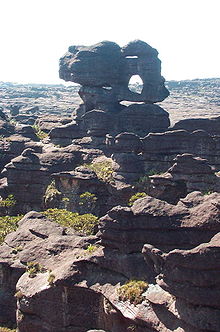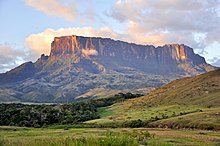Tepui
Tepuis are by erosion resulting detached, until almost 3000 meter high mesas in the western highlands of Guiana on the northern edge of the Amazon basin in the countries Venezuela , Guyana and Brazil .
The tepuis are mostly made of sandstone and have some steeply sloping gorges and crevices, the plateau can often only be reached from the air.
Formation of the table mountains
The term Tepui for table mountains is taken from the Pemón language and is translated by many authors as 'House of the Gods'. They are remnants of a mighty, quartzitic sandstone plateau that once covered the granite bedrock between the northern border of the Amazon lowlands and the Orinoco , between the Atlantic coast and the Rio Negro . The plateau was eroded over the course of the earth's history . The Tepui are island mountains that have remained standing .
In the Gran Sabana in southeastern Venezuela, on the border with Guyana and Brazil , there are 115 such table mountains today. The steep mountains rise up to 1000 meters above the rainforest . The surfaces of the mountains have different textures. On the plateaus of the mountains, dense impenetrable forests alternate with rugged, rugged rocky landscapes with a great diversity of species. The erosion and weathering has created bizarre rock formations and labyrinths over the course of millions of years. This process is also called taverning . In the tepuis there are also spectacular cave systems such as the Muchimuk cave system in the Churí-Tepui , the Cueva Ojos de Cristal in the Roraima-Tepui or the shaft caves of the Sarisariñama-Tepui .
Flora and fauna
The Tepuis plateaus are almost completely isolated from the rainforest. This is due on the one hand to their height and the resulting climatic differences to the rainforest and on the other hand to their insurmountable steep walls. This isolation, existing for millions of years, led to an endemic flora and fauna. There is a temperate, cool climate on the surfaces with frequent thunderstorms, and at the foot of the mountains a tropical and humid climate. In the isolation, evolution on the plateaus has produced a very unique animal and plant world. Many of the plants and animals of the Tepuis are unique and cannot be found anywhere else in the world. So far, seven small mammals are known that are only endemic to the Tepui region. These are three kinds of bag rats Tepui dwarf opossum ( Marmosa tyleriana ) which Pantepui slimming opossum ( Marmosops pakaraimae ) and Reigs shrew opossum ( Monodelphis reigi ), a Fledertierart , the Golden strip fruit vampire ( Platyrrhinus aurarius ) and three rodents that Roraima mouse ( Podoxymys roraimae ), the Tepui climbing mouse ( Rhipidomys macconnelli ) and the Wetzel-climbing mouse ( R. wetzeli ). The nutrient-poor soils of the table mountains lead to a rich variety of carnivorous plants , their rugged, weathered stone soils do not hold a humus layer in thunderstorms.
The table mountains - also called islands above the rainforest - are still a challenge for researchers today, as they have a high population of as yet unknown species. Some tepuis are shrouded in thick clouds for most of the year. So far, their surface could only be photographed with radar images from helicopters. The surface of some tepuis has never been stepped on by a person.
Occurrence
A large number of the table mountains are located in the Canaima National Park in Venezuela. This was included in the list of world cultural and natural heritage of humanity by UNESCO .
A total of 115 tepuis exist, including
- Acopan-Tepui : The Acopan-Tepui is a 2112 meter high table mountain in Bolivar / Venezuela with a 700 meter high, heavily overhanging north pillar.
- The Aparaman group includes: Aparaman-Tepui , Murosipan-Tepui , Tereke-Yuren-Tepui and Kamarkaiwaran-Tepui .
- Autana-Tepui : It towers above the jungle up to 1,300 meters. Within this tepuis there are gorges up to 400 meters deep, which are called Simas. It is believed that these holes were once huge caves, the roof of which collapsed at some point.
- Auyan-Tepui : This most famous table mountain has a surface of 700 km². The highest waterfall in the world falls from its plateau - the Salto Ángel .
- Kukenam-Tepui : The Kukenam-Tepui is considered a sacred mountain by the indigenous people. It has not been allowed to climb since 1997, especially since the ascent and the high plateau are particularly prone to accidents.
- Neblina-Tepui : also called Pico da Neblina, is the highest table mountain at almost 3000 m.
- Ptari-Tepui : The cliff face of the Ptari-Tepui is so isolated that one suspects a particularly high number of endemic plant and animal species on it.
- Roraima-Tepui : Reports by the famous South America researcher Robert Schomburgk inspired the English country doctor Arthur Conan Doyle to write his novel The Lost World about the discovery of a living prehistoric world full of dinosaurs and primeval plants.
- Sarisariñama-Tepui : At 2300 m height one of the highest tepuis, far away and best known for two huge, circular holes in the plateau.
literature
- Uwe George : Islands in Time. Expeditions to the last white spots on earth. 6th edition. Gruner and Jahr, Hamburg 2005, ISBN 3-570-06212-0 .
- Roland Stuckardt: Seats of the Gods. In: terra . Issue 3. Tecklenborg, Steinfurt 2004.
supporting documents
- ↑ Juan F. Díaz-Nieto, Robert S. Voss: A Revision of the Didelphid Marsupial Genus Marmosops, Part 1. Species of the Subgenus Sciophanes. Bulletin of the American Museum of Natural History Number 402: 1-70. 2016, doi: 10.1206 / 0003-0090-402.1.1 . Pages 21–25.
Web links
- Gods in the ejection seat , Wolfgang Hess, August 1, 1998, on Wissenschaft.de



